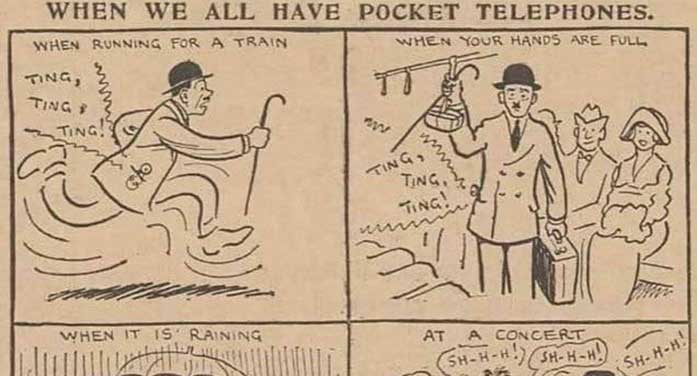 Can people see into the future and predict what’s about to come?
Can people see into the future and predict what’s about to come?
Most of us recognize that the answer is, sadly, an emphatic “No.”
Nevertheless, our society has long been fascinated with religious and non-religious prophets, seers and others making predictions. Several works – including the seventh-century Chinese book Tui bei tu, Geoffrey of Monmouth’s 11th-century Latin work Prophetiae Merlini and Nostradamus’s famous 16th-century collection Les Prophéties – still intrigue people.
Some far-flung prophecies and predictions about travel and communication did become part of our reality.
The early wagonways in ancient Babylon gradually transformed into the iron rails of the locomotive. The Wright brothers helped launch the age of flight in 1903 at Kitty Hawk, N.C. Henry Ford’s Model T was a low-priced, affordable automobile for middle-class Americans when introduced in 1908. Lunar programs in the U.S. and the Soviet Union gave us early images of the moon and led to the space race, which the United States won when Neil Armstrong walked on the mysterious natural satellite during the 1969 mission of Apollo 11.
Phonographs, radios and television sets were all envisioned (in one form or another) and came to fruition. And look at how far computers, robotics and other electronic gadgets have come.
Science fiction writer H.G. Wells notably predicted a few things correctly, including the earliest known mention of email. “For in Utopia, except by previous arrangement, people do not talk together on the telephone,” he wrote in his 1923 classic Men Like Gods. “A message is sent to the station of the district in which the recipient is known to be, and there it waits until he chooses to tap his accumulated messages. And any that one wishes to repeat can be repeated. Then he talks back to the senders and dispatches any other messages he wishes. The transmission is wireless.”
Here’s another surprising prediction with some validity: A cartoonist envisioned an eerily astute prototype of the mobile phone.
The prediction was unknown to me until last weekend. Maks Viktor Antiquarian Books highlighted the fascinating and prescient cartoon in a June 9 Facebook post. Entitled “The Pocket Telephone: When Will it Ring?,” it was drawn by British cartoonist William Kerridge (W.K.) Haselden in the Daily Mirror as early as March 1919 or as late as 1923. (It was reproduced by Myko Clelland, the Scottish-based director of European Content for My Heritage, in a Jan. 31, 2018, tweet.)

“The Pocket Telephone: When Will it Ring?” by British cartoonist William Kerridge (W.K.) Haselden
I’m familiar with some of Haselden’s work. Trained as an underwriter, his passion for cartoons and caricatures ultimately led him to publications like Punch, St. James’s Gazette, The Sovereign and the Tatler. His greatest success was with the Mirror, where he worked full time from 1903 to 1940 and was described as the father of the British strip cartoon.
Haselden was also known for making bold predictions. His dream sequences about women and romance and fashion weren’t too far off the mark. The same could be said for his analysis of something akin to camera phones.
His strip on the pocket telephone, which I had never seen before, may very well be the boldest and most accurate prediction he made. While some people surely dreamed up ways to have smaller and more accessible phones, no such thing existed at that time.
It’s also possible that Haselden loosely based his strip on obscure U.S. inventor Charles E. Alden’s 1906 claim that he came up with an idea for a “vest pocket telephone.” The story was published in the New York World, Los Angeles Herald and New Orleans Bee and could have been picked up by British wire services. Alden never filed a patent, so it may have either been a working proposal or an amusing tall tale.
“The latest modern horror in the way of inventions is supposed to be the pocket telephone,” according to the description below Haselden’s strip. “We can imagine the moments this instrument will choose for action!”
Indeed, the six panels deal with situations that some of us have faced – or are fearful that we may face – with our cellphones, iPhones, Androids and other handheld devices. We see a gentleman’s pocket telephone cascading with a noisy “ting, ting, ting” as he’s running to a train, when his hands are full, in the pouring rain, at a concert, holding a baby and even when he’s about to be married.
Quite something, isn’t it?
While we obviously can’t predict the future, maybe we should draw the faintest of lines from Haselden’s imaginary pocket telephone to the mobile phone. Seems like the right call.
Michael Taube, a Troy Media syndicated columnist and Washington Times contributor, was a speechwriter for former prime minister Stephen Harper. He holds a master’s degree in comparative politics from the London School of Economics. For interview requests, click here.
The opinions expressed by our columnists and contributors are theirs alone and do not inherently or expressly reflect the views of our publication.
© Troy Media
Troy Media is an editorial content provider to media outlets and its own hosted community news outlets across Canada.

